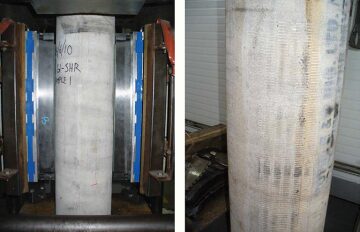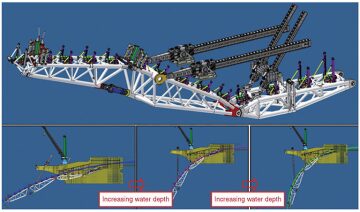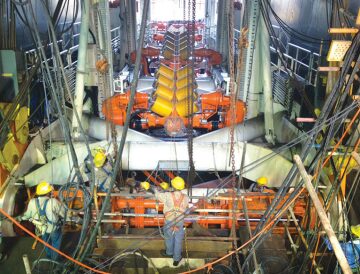During the Offshore Technology Conference (OTC) in Houston last month, offshore construction capabilities drew a room-capacity audience to a technical session about advances in deepwater construction techniques and vessels, including pipelaying and heavy lifting.
Handling Increased Tensions in Deeper Water Depths
With ultradeep installations reaching deeper than 2000 m, laying pipe on the seafloor can present challenges, such as increased holding tensions on the pipe during installation. Proper tension must be maintained to prevent the buckling that can be caused by the hydrostatic pressures acting on the pipe.
Roberto Faldini of Saipem described new designs and capabilities of S- and J-lay vessels developed to meet the demands of deeper water depths. He said that the “ultra-deep scenarios, unimaginable and out of reach just a few years ago, require the new generation of S/J-laying vessels to be capable of applying pipe-holding tensions beyond 500 tonnes during normal operations, which may become twice or three times that value if the pipelines are unexpectedly flooded.”
During S-lay pipeline installation, the vessel moves forward while the pipe is fed off the back of the vessel, curving downward through the water until it reaches the seafloor. During the process, the pipe forms an “S” shape under the water. To support the pipe as it is moved in the water and to control the curvature, stingers extend from the vessel.
During J-laying of pipe, the pipeline is inserted into the water almost vertically by the use of a tower on the vessel. The pipe curves once, forming a “J” shape under the water. Generally, the J-lay pipeline can tolerate more underwater currents and motion than pipe being installed by the S-lay method.
FDS2 is the second field development ship recently built by Saipem. It has a 1,000-tonne capacity crane and is equipped with a J-lay tower able to lay pipes from 6-in. to 32-in. diameters, assembled in quad joints up to 52 m long with a maximum tension capacity of 1,500 tonnes in normal mode and 2,000 tonnes in emergency/contingency conditions. The ship was designed to be also converted to S-lay mode to handle pipe to water depths greater than 2000 m.
The J-lay system of the FDS2 has been equipped with new compliant pads, allowing the application of up to 2,000 tonnes of holding tension in both normal laying and contingency situations, using standard friction clamps of relatively small dimensions. The vessel's pipe-holding clamps are equipped with pads able to increase the equivalent friction factor and to accommodate different pipe diameters, thus making them compliant with a wide range of pipe dimensions.
The pads are equipped with a toothed bar retained inside a steel support by molded polyurethane (PU). The PU enables the bars to move and to adapt to different pipe diameters, maximizing the contact surface and helping to spread the hold tension evenly (Fig. 1). The bars are flush with the bottom of the casing to transfer the axial load. The axial load-sharing pad acts like a shear spring, distributing the axial load evenly on the six rows of the clamp.

Faldini said that the use of standard materials resulted in limited adaptability to different pipe diameters, requiring longer periods of time offshore to change the pads so that they fit the pipe diameter before resuming the installation operations. He said cost and time savings are achieved with the toothed bars’ ability to adapt to different pipe diameters and the ability to use the same pads for different pipe sizes.
Saipem’s CastorOne S-lay vessel can lay pipes up to 60-in. diameter, prefabricating pipe strings 36 m long with the capability of joining 2×18-m-long pipes as an alternative to 3×12-m-long conventional joints. The articulated stinger is designed for any pipe diameter and water depth through continuous control of the overbend stresses in the pipe (Fig. 2).

In case of a wet buckle of the pipe or in a contingency flooded pipe scenario, it has the capability to hold and then abandon the pipeline in a controlled way by applying a 1,500-tonne tension through the simultaneous use of an abandonment and recovery winch, three tensioners, and a pipe-holding indentation clamp—all rated 750 tonnes.
CastorOne completed its first deepwater job last summer, laying the 136-mile-long, 24-in. Walker Ridge oil export pipeline from Chevron’s Jack and St. Malo fields in 7,021 ft of water north to a platform in Green Canyon. After the completion of two more assignments in the US Gulf of Mexico (GOM), Big Foot for Enbridge and Keathly Canyon for Williams, the vessel is scheduled to install the 236-mile-long, 24-in. Tupi NE-Cabiunas trunkline in Brazil's Santos Basin for Petrobras in up to 2230 m of water. Next year, it will install the 552-mile-long, 42-in. INPEX-operated gas trunkline offshore northwest Australia, in up to 275 m of water.
Putting a New Spin on Pipe Reeling Logistics
Jan van der Graaf of Heerema introduced the Aegir, a multipurpose monohull vessel for heavy pipelay in combination with heavy lifting. It is equipped with exchangeable reels, which enable it to remain in the field during pipeline reeling operations. He said, “This efficiency gain will induce a step change in the economics of reeling.” Operators using the vessel will have the advantage of having one ship for field development work instead of two or more. It is the first vessel in the world to use a portable reel system. The reels are delivered on site, which avoids having to sail back and forth to the spoolbase on shore, thus saving valuable vessel time. The vessel can also rapidly switch from reel-laying to J-laying activities.
Before the company began the design of the vessel, a question had to be answered: Is the method of exchangeable reels a viable concept? If so, the lifting of the reels and their presence on the deck, by definition nearby the crane, would have a major effect on the layout of the vessel. A benchmark study was run, which confirmed that under favorable conditions, the lifted reels concept could be 50% faster than conventional reeling and more than twice as fast as J-lay (Fig. 3) when multiple reel loads are involved.
The lifted reels concept was also appraised to be cost-competitive. Van der Graaf said, “The method draws its advantages from keeping the expensive pipelay vessel on reeling, whereas conventional reeling vessels spend only a third of their time on reeling, with the other two-thirds being needed for sailing and spooling."
Comparisons of the logistics were made under two conditions. In the first, the new full reels can be transferred to the vessel and empty reels removed in noncritical time during the time that the operational reel is reeled off, because many of the vessel’s reeling activities are foreseen to take place in ocean swell areas. The second condition was that a logistic chain could be set up at the anticipated reduced costs to guarantee a continuous flow of reels to the vessel at the pace it is reeling them off.
The concept of lifted reels affected the deck layout. To achieve a continuous reeling operation, three reel positions were required: an operating position in line with the pipelay tower; a full reel storage position that would allow the taking on board of a next full reel in noncritical time, and an empty reel position to which an empty reel could be disposed for liftoff in noncritical time. A shared skidding system was to displace the reels from position to position, independent of the crane. The concept required a row of reels close enough to the crane to take a 3,000-tonne full reel on board and lift a 1,000-tonne empty reel off at convenient radii.
The row of reels across the deck in front of the crane dictated that the pipelay tower be placed amidships. A position on the stern next to the crane was not possible. At amidships, the tower was placed in the center of the vessel because the heave and pitch motions are the least, which was considered favorable for sensitive deepwater lowering operations.
The positioning of the tower in the center of the vessel demanded a moonpool. The moonpool's length was determined by the requirement of shallow pipelay up to a tower angle of 50°. Its width was determined by the requirements for the passage of pipeline end terminations, inline tree assemblies, and and buoyancy tanks. The result was a moonpool measuring 25 m long and 10 m wide.
The space between the moonpool and the accommodation was made long enough to allow for the passage of 50-m-long quad sections across the deck. Adding up the dimensions required that the existing vessel concept be lengthened to an overall length of 211.5 m. The width of the vessel has been kept at the original 46.2 m.
When the crane and tower were placed at the centerline of the vessel, the crane boom could be not be laid down and the tower could not be sufficiently inclined. It was found that this problem was solved by placing the crane on the starboard aft corner of the vessel and the tower with the moonpool slightly off-center to the portside. In these positions, all requirements could be fulfilled.
Offshore Reel Transfer

Benchmarking determined that on an average deepwater infrastructure project, a new reel would be needed every few days. Time traces were run for several offshore arenas in the world for different seasons of the year. It was concluded that two measures had to be taken for a continuous supply of reels:
- Make it possible to adapt the vessel heading for reel transfer
- Prevent pendulum motions of the reel during transfer
With both measures in place, it was found that in the installation season, in all offshore arenas of the world, a new reel could be transferred with fair probability in noncritical time before it was needed by the Aegir.

Van der Graaf said, “The economics of the lifted reels concept depend on spooling and transport being done at a lower day rate for the equipment than with conventional reeling vessels.” Reels can be spooled either on the transport vessel or on the quay. Stalk length and spoolbase size can be tuned to the requirements of the projects. Transport can be done with tugs and barges or with fast heavy lift vessels, depending on optimum project costs.
When the vessel is working on a series of projects needing a continuous flow of reels, there are fewer reels than there are reel fillings to be supplied to the field. A just-in-time supply chain is then required. The speed of the supply chain is driven by the vessel, since it has the highest day rate. The pace of the spoolbase process, driven by stalk length and tie-in time, and the speed of the transport process, determined by the number of vessels, sailing distance, and speed, are adapted to the rate of the Aegir’s offshore work.
As a multipurpose installation vessel, the Aegir is often expected to work on a mixed portfolio of reeling, J-lay, or other installation activities. In such a scenario, the project execution plan can be further optimized by careful planning.
In general, lifted reels involve a cheaper transport process as compared with conventional reeling, in which all transport and spooling is done with the expensive pipelay vessel. The cheaper transport vessels relieve the pressure on the spoolbase process, allowing for shorter stalk lengths and thus, an easier selection of spoolbases at lower costs.
The absence of the reeling vessel for spooling requires extra investments for spooling, the most important ones being a back tensioner, a fleeting device, and a unit for driving the reels. Van der Graaf said these investments are moderate. It is a goal to keep the weights of this equipment low and minimize their handling to keep the operational costs low.
The vessel completed its first installation project in Anadarko’s Lucius offshore field in the GOM in the fourth quarter of 2013, where it was used for installation of the subsea manifolds, production flowlines, production risers, and export risers.
Van der Graaf said, “The next project will take place in deepwater China and then INPEX’s Ichthys LNG development for the transportation and installation of infield flowlines, subsea structures, and moorings for future floating production, storage, and offloading and central processing facilities.”
For Further Reading
OTC 25101 Deepwater Construction Vessel ‘Aegir’ Shifting the Frontiers of Reeling by J. van der Graaf and K. van Zandwijk, Heerema Marine Contractors.
OTC 25110 CastorOne and FDS2: Getting Stronger for Laying Deeper by R. Faldini, S. Marchini, A. Oldani et al., Saipem.


